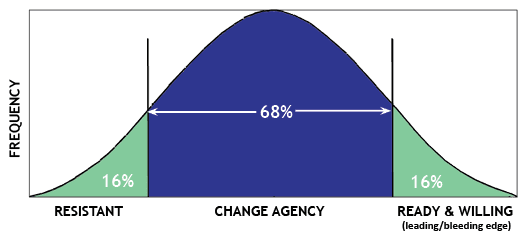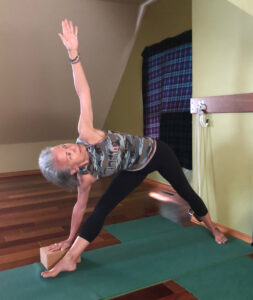In the words of Malcolm Gladwell, “cultural legacies cast a long historical shadow.”
They persist, generation after generation, virtually intact,
even as the economic and social and demographic
conditions that spawned them have vanished.
Outliers: The Story of Success, 2008
In many workplaces, one such cultural legacy experienced on a daily basis is our respect for or fear of authority. Another is gender-based salary inequity — women’s $.66 to men’s $1. Other cultural legacies include racism, class division, and such generational advantages or limitations as wealth or poverty.
As a society, whether regional, national or global, we have witnessed humans clinging to cultural ethos long past their due dates. On the surface, one might surmise this as an instinctive (fight-flight) resistance to change. However, our experiences with organizational change and new product adoptions have taught us that the Bell-shaped curve is the normal distribution. The implication — 60% to 80% of the population in question are waiting to see which of the outliers (resistors or bleeding-edgers) have made the right choice.
So how do we move society toward greater change agency, particularly in an era where change appears to be the only constant?
Whether cultural or technological, change provides us with three options:
- Regress – go back to simpler, less complex times
- Stay – continue with the status quo or the familiar
- Innovate – go forward into the unknown and adapt/transform who we are and thereby what we experience
Although simplicity tugs at me when I stand in the grocery aisle trying to decide which tooth paste to buy, in the final analysis, I do prefer the customized product that suits my needs. In essence, the persistent change required of me is to be aware of what my needs are. Thus innovation, whether technological or cultural, always begins with personal change —
- Letting go of old and unserving beliefs, attitudes and behaviours
- Attending to why change now (the intention or purpose behind the change), what to do now (the content), and how to do it now (the process)
In a world where cultural change is no longer a simple shift from one to another familiar way of seeing or being, what do we connect with and learn from in an unknown future? I use the following to guide me through what is emerging:
- Shift from only reacting and redesigning (technical problem solving) to include reframing (social behaviours and attitudes) and transforming (social identity change; reinvention)
- Access deeper levels of learning with this non-traditional formula: show up (become self-aware); open up (receive what is being offered and allow what is within you to emerge); see the truth (reflect on your experience); and accept what is (what emerges is your act of creation; accept it is here for a reason).
- Integrate intuition with your other intelligences to guide you when past knowledge and experience are not enough.
- Eliminate three hurdles: judgment (blocks an open mind); emotional separation (blocks an open heart); fear of letting go of what we have and who we are (blocks willingness to act).
- Create three spaces: co-sensing spaces (to facilitate a shared sense of what is actually going on); co-meditation spaces of deep reflection and silence (that connect us individually and collectively to our creative core); co-creation spaces (that facilitate discovery by collaborative action)
- Let go of everything nonessential to allow for rebirth.
- Simultaneously attend to individual, community, institutional and global systems.
Affecting change on any scale may be resisted because it demands effort and hard work. However, the lack of opportunity to change one’s circumstances and experience often presents a greater barrier than one’s willingness or lack of willingness to change. In my own experience as a change agent, when everyone is given the opportunity to contribute to something new, they are much more willing to change themselves and their behaviour as a means to that end.
Furthermore, Gladwell claims those who are successful in changing their lives are more likely to receive special opportunities that lead to further success. These achievers of change “are products of history and community, of opportunity and legacy.” In other words, the advantages and inheritances they receive are critical to their successful change efforts. Thus the gifting of opportunity is an argument in favour of successful and very likely accelerated change management — maybe even in our lifetime.
At this time of gift giving, what “gift of opportunity” could you give to someone to change you and them? To change your community? To change your world?
For more information on successful change strategies, click here.






